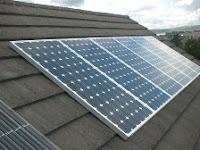 Due to the increasing improvement in solar power systems lately, many homes are solely dependent on solar power globally. This leads to the question of how solar energy is put to use. It is claimed that most solar power systems can collect heat created by sunlight striking an object. An example of this is to simply concentrate light with mirrors or lenses to produce enough heat to start a fire. This indirect method of producing solar power is known as "Concentrating Solar Power" (CSP). As briefly mentioned earlier, CSP systems use the simple technology of lenses or mirrors and tracking systems to focus a large area of sunlight into a small beam. The consequential heat is then used as the heat source for a conventional power plant. The "Parabolic Trough" and the "Stirling Dish" are two examples of concentrating technologies. In all concentrating solar power systems a working fluid is heated by the concentrated sunlight.
Due to the increasing improvement in solar power systems lately, many homes are solely dependent on solar power globally. This leads to the question of how solar energy is put to use. It is claimed that most solar power systems can collect heat created by sunlight striking an object. An example of this is to simply concentrate light with mirrors or lenses to produce enough heat to start a fire. This indirect method of producing solar power is known as "Concentrating Solar Power" (CSP). As briefly mentioned earlier, CSP systems use the simple technology of lenses or mirrors and tracking systems to focus a large area of sunlight into a small beam. The consequential heat is then used as the heat source for a conventional power plant. The "Parabolic Trough" and the "Stirling Dish" are two examples of concentrating technologies. In all concentrating solar power systems a working fluid is heated by the concentrated sunlight.It is then used for either power generation or energy storage. Furthermore, it is important to provide the continuous availability of energy since solar energy is not available during the night. Since solar power is an intermittent energy source, all available energy made available should be taken when available, stored, or transported via transmission lines to where it can be used. In storage solar energy is stored at high temperatures using molten salts. These molten salts have low-cost, high specific heat capacity and can distribute heat at temperatures compatible with conventional power systems. This expertise helps increase efficiency of the system.
A direct method of solar technology involves the "Photoelectric Effect". It was in 1839 that Edmund Becquerel discovered the technique of producing an electric current in a solid material using sunlight. Once this method developed it was found out that photoelectric or photovoltaic effects caused certain materials to switch light energy to electrical energy at an atomic level. The Photoelectric Effect uses the simple method of reflecting, absorbing or direct pass of light. However, it is only the absorbed light that can actually generate electricity.
Hopefully this information should be useful if you are considering using solar power as an energy source for your home. Just remember even though there are certain disadvantages to think about, the number of advantages outweigh the number of disadvantages. These disadvantages can be improved vastly as technology improves. Additionally, it is important to keep in mind that solar powered appliances have vastly changed for the better when compared to ten years ago.
Bear in mind that home solar power systems are suitable in regions with a lot of available sunlight. So do not opt out to get a solar panel system unless you are completely sure of the surroundings. Again, as suggested earlier, it is best to have an alternate energy source in case of low availability of sunlight. Although solar power is an energy source that has only been recently utilized, it might just become the most crucial energy source of the future. Learn how to build a solar panel today!
Useful information generate electricity:
http://ezinearticles.com/?Generate-Electricity-With-a-Magnetic-Power-Generator&id=3716166
Useful information home solar power systems:
http://www.diyhomebuildingkits.com/index.php?p=articles/solar-systems/home-solar-power-systems-uses
Learn how to build a solar panel:
http://ezinearticles.com/?Learn-How-to-Build-a-Solar-Panel-to-Save-Electricity-in-Your-Home&id=2727558












